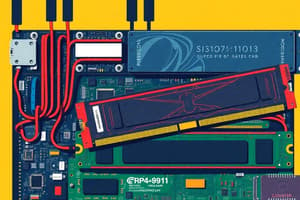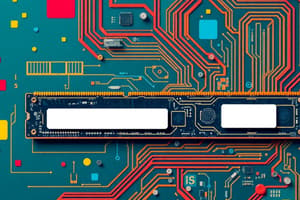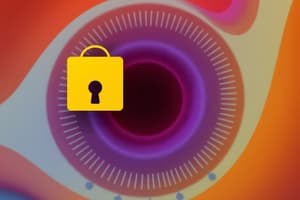Podcast
Questions and Answers
What is the primary advantage of portable computers over desktop computers?
What is the primary advantage of portable computers over desktop computers?
- Portability (correct)
- More powerful components
- Larger storage capacities
- Better cooling systems
Which type of computer is typically meant for stationary use in offices or homes?
Which type of computer is typically meant for stationary use in offices or homes?
- Desktop computers (correct)
- Tablets
- Smartphones
- Laptops
What type of device is not mentioned as an input device for computers?
What type of device is not mentioned as an input device for computers?
- Touchscreens
- Scanners
- Projectors
- Microphones (correct)
Which component of a computer processes the data entered through input devices?
Which component of a computer processes the data entered through input devices?
What is the purpose of output devices in computers?
What is the purpose of output devices in computers?
What is the main difference between volatile and nonvolatile memory?
What is the main difference between volatile and nonvolatile memory?
Which type of memory is RAM an example of?
Which type of memory is RAM an example of?
What is the function of cache memory in a computer system?
What is the function of cache memory in a computer system?
Which of the following is an example of nonvolatile memory?
Which of the following is an example of nonvolatile memory?
What is the purpose of a solid-state drive (SSD) in a computer system?
What is the purpose of a solid-state drive (SSD) in a computer system?
Flashcards are hidden until you start studying
Study Notes
What is a Computer?
A computer is a programmable machine designed to process data and perform tasks automatically by following instructions from programs stored on it. Computers come in various forms, including desktop computers, laptops, tablets, smartphones, and servers. They are used for a wide range of purposes such as communication, gaming, education, business transactions, and scientific computations.
There are two main types of computers based on their size and performance:
-
Desktop computers: These are larger devices meant for stationary use in offices or homes. They typically have more powerful components like high-speed CPUs, larger storage capacities, and better cooling systems compared to other portable devices.
-
Portable computers: These include laptops, tablets, and smartphones. Portability is their primary advantage, allowing users to easily move them around and use them in different locations. Laptops can also offer similar performance to desktops with advances in technology like slim designs, lightweight materials, and advanced graphics cards.
Computers operate through input devices like keyboards, mice, touchscreens, and scanners. Data entered into these devices is processed by the CPU, a part of the computer's central processing unit. This information can take many forms, such as images, text, audio, or video. After processing, computers display information using output devices like monitors, printers, speakers, and projectors.
Computer memory is essential for temporary storage of data required for immediate use. There are two main types of computer memory: volatile and nonvolatile:
-
Volatile memory: This type of memory requires electricity to maintain stored data and loses all stored information when power is turned off. Examples include RAM (random access memory) used temporarily while programs run, and cache memory, which stores recently accessed data for faster retrieval.
-
Nonvolatile memory: This type retains stored data even without electricity. Common examples are hard drives, solid state drives (SSD), CDs, DVDs, and flash drives. These storage systems allow users to store large amounts of data permanently and safely.
In summary, a computer is an electronic device designed to process and manipulate digital data. They come in various forms and sizes, allowing them to serve diverse purposes. Understanding their components and how they operate can help users maximize their potential and navigate the digital world effectively.
Studying That Suits You
Use AI to generate personalized quizzes and flashcards to suit your learning preferences.




